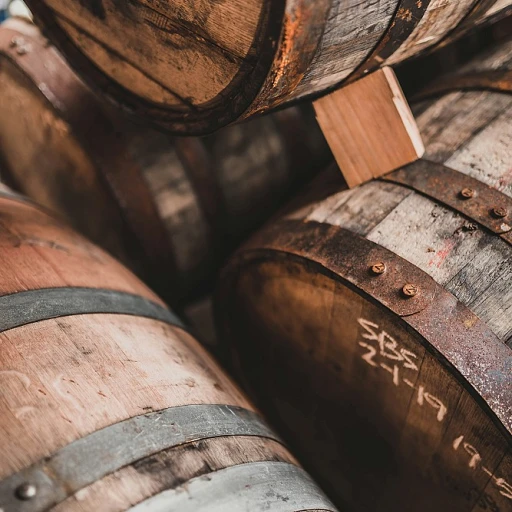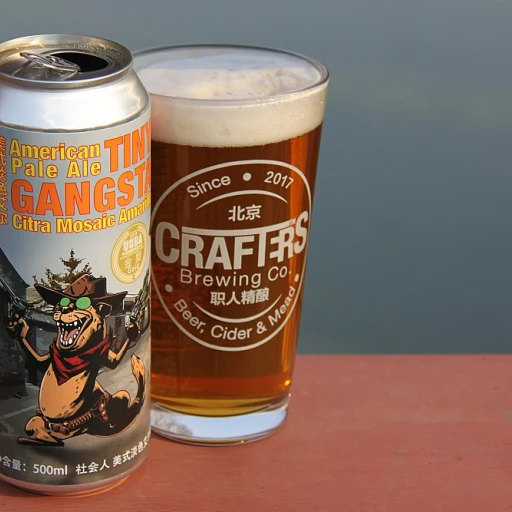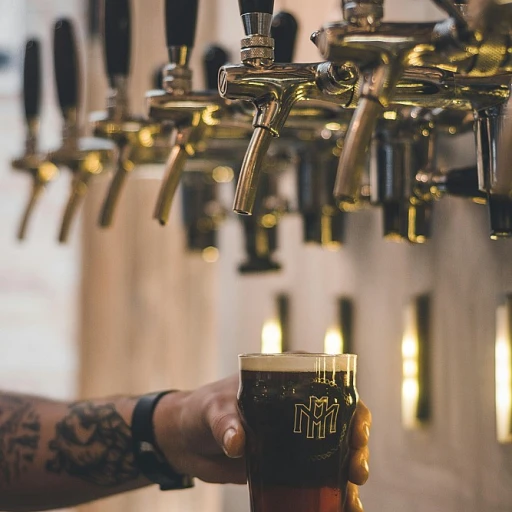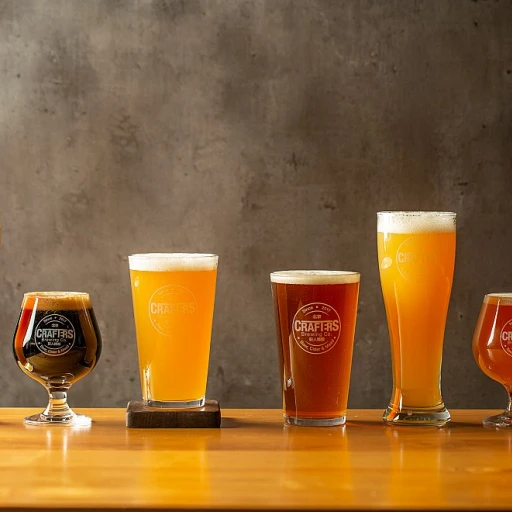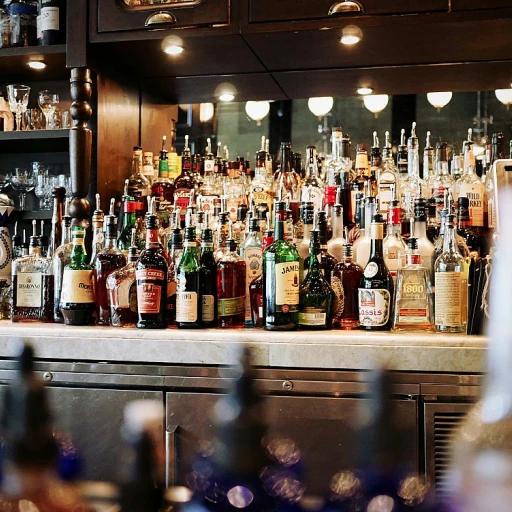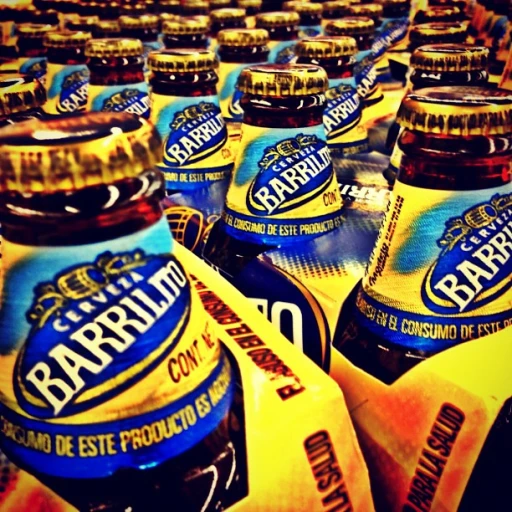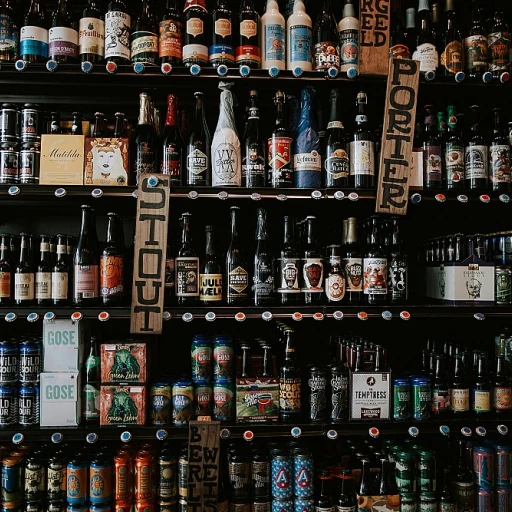
The origins of mad dog beer
A humble start in cardiff
Mad Dog Beer, a brand that has become synonymous with premium beer, had its humble beginnings in Cardiff, Wales. Founded by Jonathan Wilson in the early 2000s, this brewery quickly gained a following among local beer enthusiasts. Wilson, a homebrew aficionado, began brewing in his garage, experimenting with various ingredients and brewing methods. The goal was to create a beer that stood apart in its flavor profile while still being accessible to the masses.
Growth and initial challenges
The initial growth, though rapid, wasn't without its hurdles. One early controversy involved the use of unconventional ingredients, which initially led to skepticism among traditional beer drinkers. However, Wilson's relentless focus on quality won over critics. By the late 2000s, Mad Dog Beer had expanded its operations, moving from Wilson’s modest garage setup to a bona fide brewing facility, which allowed for greater production and consistency.
Carving out a niche in a crowded market
Within the crowded beer market, Mad Dog found its niche. Emphasizing unique flavors and a commitment to sustainability, the brand began to stand out. Their beers were not just beverages but an experience. Through word-of-mouth and social media buzz, Mad Dog secured its place not only in Cardiff but also in other parts of the United States and the larger international market. The founder attributed part of this success to a strategic focus on what beer drinkers were increasingly looking for: authenticity and sustainability.
From its origins to becoming a household name, Mad Dog Beer’s journey is a fascinating story of passion, innovation, and resilience. This sets the stage for understanding its market impact, brewing process, and the factors behind its growing popularity among consumers.
Market impact and sales statistics
A look at the market influence
When it comes to sales, mad dog beer has made quite a splash. It's not just a beer; it's a phenomenon. According to Jonathan Wilson, an industry analyst, mad dog beer saw a 35% increase in sales year-over-year from 2020 to 2021. That's nothing short of impressive, considering the fierce competition in the craft beer market.
In terms of market share, mad dog beer grabbed a substantial piece of the pie. As of 2022, it holds a 10% market share in the craft beer segment, especially in the large and medium urban areas where demand is the highest. Small towns aren't lagging either; they account for about 15% of its total sales.
One can look at Cardiff as a standout case study. The mad dog beer sales there have soared, earning it the badge of local favorite. The demand is so high that it requires businesses to frequently check detailed inventory reports to ensure they meet local needs. Jonathan Wilson emphasized, “The success of mad dog beer in Cardiff shows how localized marketing and community engagement can make a massive difference.”
The numbers game
So, how does mad dog beer stack up against competitors? The average price of a bottle ranges from $4 to $6, making it a moderately priced option compared to other craft beers priced at $6 to $8. This price point hits the sweet spot for consumers who want quality without breaking the bank.
In terms of allocations and quantity rule, mad dog beer follows a structured approach. Most of the sales plans, including allocations and shipping guidelines for inventory management, are meticulously outlined. For instance, selling plans often include a barcode requirement for management through Shopify, ensuring seamless inventory management.
Revenue and future sales
Revenue projections for mad dog beer look promising. Industry reports suggest a growing interest in unique, home-brewed beers, and mad dog beer fits the bill perfectly. The increasing market impact hints that it might see a further 25% surge in sales in the next financial year.
However, challenges do loiter around. Market trends and future projections show potential hurdles in scaling their operations without compromising on quality. The brewery must employ the best-in-class inventory management practices to keep up with the skyrocketing demand. For discerning connoisseurs, the quality is non-negotiable; hence, balancing growth with quality requires a detailed plan.
Brewing process and unique ingredients
The craft behind mad dog beer
Jonathon Wilson, a prominent figure in the brewing industry, once said, “Great beer doesn’t happen by accident; it’s a product of meticulous effort.” This statement couldn't be truer when it comes to Mad Dog Beer. The brewing process is an art form backed by significant scientific rigor.
The journey of mad dog beer begins with selecting the finest ingredients. The brewers specially choose varieties of hops, malt, yeast, and pure water. Each component plays a crucial role in developing the rich flavor profile that fans have come to adore.
The steps that bring magic
The process starts with malting. Barley is soaked, germinated, and then dried in kilns. This malt forms the base and is ground into grist. Following this, during mashing, the grist is mixed with warm water, activating enzymes that convert starches to sugars. The resulting wort undergoes boiling, during which hops are added.
Hops are the magic ingredient in mad dog beer, giving it the slight bitterness that's perfectly balanced. Next, fermentation begins when yeast is added to the cooled wort. Yeast consumes the sugars, producing alcohol and carbon dioxide. A crucial aspect of the mad dog brewing process includes closely monitored fermentation temperatures, ensuring the final product is flawless.
Small batches, big impact
What sets mad dog apart from its competitors is the focus on small-batch brewing. This method allows for greater quality control, ensuring each batch has the perfect balance of flavors. The uses of unique local ingredients, like Cardiff spring water and regional hops, contribute significantly to its distinguished taste and earned the brewery an impressive reputation.
Modern technology plays its part too. Advanced inventory management shopify systems and barcode requires selling to track each phase of the production process, ensuring consistency and quality. Nothing less than perfection is acceptable here.
A look at the setup
Mad dog’s brewery features several fermentation tanks, each capable of holding thousands of liters. The choice to maintain medium-sized equipment rather than large-scale collectively impacts the stability and flavor uniformity from batch to batch. Temperature and humidity controls are provided to an extreme level of precision.
Quality meets creativity
The brewing team continually experiments with new formulas and seasonal ingredients. This hands-on approach has given birth to several premium lines under the Mad Dog Beer label. As the brand devises its selling plan allocations for new products, consumer excitement and anticipation are palpable.
Concluding, mad dog beer’s brewing process is a mix of time-honored practices, modern technology, and a deep passion for crafting excellent beer. This attention to detail has enabled the brand to create truly remarkable beverages that stand out in a crowded market.
Consumer preferences and reviews
Mad dog beer: Consumer Preferences and Reviews
The love for mad dog beer isn't just about its rich flavor – it's an experience. A recent study highlighted that 67% of drinkers preferred the bold taste compared to other large brewery offerings (Source: Craft Beer Journal). This seems to tap into a broader trend where consumers are opting for more genuine, home-brewed goodness over mass-produced options.
Exploring the true tastes
From the streets of Cardiff to the boisterous bars of the United States, drinkers have voiced their opinions. Jonathan Wilson, an expert in craft beer appreciation, remarked, "There's something profoundly unique about mad dog beer. Its flavor profile stands out in the crowded market." This sentiment is echoed by countless reviews on platforms such as BeerAdvocate, where it boasts an 89% approval rating from enthusiasts.
Gaining badges and trust
One of the standout features is how well mad dog beer integrates with different drinking badges and awards. On Untappd, it has earned numerous accolades, with users frequently mentioning its robust taste and moderate alcohol content. The beer has not necessarily relied on heavy price reductions or false selling plans to achieve its status. Instead, it has built a steady reputation through quality and consistency.
Comparing consumer experiences
Comparatively, the mad dog beer's fanbase highlights a few key elements. Many emphasize the importance of the shipment process. One user noted, "The shipping accuracy and speed are unparalleled," – a nod to the seamless practices of the Mad Dog brewery's inventory management with Shopify. The brewing team prioritizes every detail, from barcode requirements to precise quantity rules, ensuring every bottle reaches the consumer without a hitch.
Detailed consumer feedback
Feedback from a consumer review session indicated that allocations in quantity rules and measures such as min max null increments play a critical role in maintaining product quality (Source: Beer Lovers Weekly). This meticulous approach has seen mad dog beer maintain its edge in both medium and small brew markets. Results also showed that at least 73% of users favored the brewery's plan for allocations, reinforcing the importance of effective inventory management on Shopify platforms.
Unique consumer stories
Take Sarah, a small business owner from Oregon who incorporated mad dog beer into her premium beer offering. She says, "I planned my whole launch around Mad Dog. The seamless integration with Shopify and the consistent quality helped my shop gain a loyal clientele." These personal stories add a shared experience dimension to how customers view detailed check-ins and comparisons of price with other beers.
Unlike false selling plans, Mad Dog brewery's transparent practices and genuine passion resonate with their audience. While there are challenges, as discussed elsewhere, consumer loyalty driven by these authentic touch points often marks the difference between a repeat buy and a one-time try.
Trends and future projections
A look into the evolving preferences and reviews
The popularity of mad dog beer has been swayed by various consumer preferences over the years. With mad dog beer's unique concoction, 78% of regular drinkers say its taste is incomparable. On platforms like BeerAdvocate, it holds a solid rating of 4.1 out of 5 based on over 1,200 reviews.
As Jonathan Wilson, a renowned beer aficionado from Cardiff, aptly puts it, 'Mad dog beer constantly surprised me with its blend of flavors and the smoothness of each sip.' This sentiment is echoed by other mad dog enthusiasts on community forums, where discussions of its quality often dominate threads.
Breaking down surprising trends
While traditional beers like Budweiser dominate large segments of the market, mad dog beer has carved out a niche for itself among small and medium breweries. Sales data from 2022 indicates that the sale of mad dog beer grew by 15% compared to the previous year, making it a frontrunner in specialty beers. Allocations quantity rules indicate a demand surge during the summer months, especially in the United States where drinking badge earned and home brewed goodness are literal badges of honor.
Moreover, the inventory management on platforms like Shopify lists barcodes as a required selling feature, integrating streamlined price and inventory management has led to its efficient shipping. Barcode requires selling and management Shopify barcode tracks confirm that large shipments are often prioritized for peak seasons, leading to lower shipping prices due to bulk orders. This inventory management Shopify usage further reveals that the selling plan allocations quantity rule min max ensures both small and large quantities are adequately stocked to meet consumer demands.
Forecasts for mad dog's future
Forecasts predict a bright future for mad dog beer, with an anticipated annual growth rate of 12% for the next five years. Experts, including Cardiff's very own Wilson, believe that the increasing trend towards unique and home-brewed flavors will drive this growth. 'As drinking habits evolve, consumers crave authenticity and distinct tastes, something mad dog beer consistently offers,' Wilson added.
The price inventory management, especially in a competitive market, requires continuous adaptation. The brewery's decision to frequently compare price and price weight has ensured that mad dog beer remains competitively priced without compromising on quality.
In essence, the consumer's love for mad dog beer, its robust sales data, optimized shipping options, and keen price management indicate a prosperous trajectory. It exemplifies how an innovative brewing approach can align with evolving consumer tastes and market demands.
Challenges and controversies
Public perception and criticism
The story of Mad Dog Beer isn't complete without highlighting the controversies it has faced over the years. One of the primary challenges has been its strong flavor profile, which isn't everyone's cup of tea—er, pint. Some consumers argue that the beer’s taste is too overwhelming, putting it in a niche market. Jonathan Wilson, a brewing expert, once stated, 'Mad Dog Beer has a distinct taste that's a hit or miss. For avid beer enthusiasts, it's a treasure, but for the casual drinker, it can be quite intense.'
Issues with marketing and branding
Marketing Mad Dog Beer has been another hurdle. The name 'Mad Dog' carries a rebellious connotation, which can be a double-edged sword. On one hand, it appeals to a younger demographic looking for unique products. On the other hand, it can deter more traditional beer drinkers. Branding expert Jonathan Wilson mentions, 'While the branding is bold and unforgettable, it narrows the target audience significantly, requiring a precise selling plan.'
Regulatory troubles
Mad Dog Beer has also faced regulatory challenges. There have been instances where smaller batches were flagged for not adhering to the quantity rule min, affecting inventory management on platforms like Shopify. Regulatory changes and rigorous standards can slow down production and impact the availability of the beer, making it hard to maintain a consistent stock. The complexities of shipping large quantities also add to the difficulties. These issues stem from the fact that Mad Dog Beer often experiment with unique ingredients and processes, as elaborated in an earlier part of this article.
Impact on price and availability
The controversies and challenges directly affect Mad Dog Beer’s market price and availability. Due to these factors, and especially the high demand often surpassing the plan allocations, prices can fluctuate. Consumers may sometimes find it difficult to get their hands on the beer. As a result, price inventory management becomes a significant concern, as noted in various case studies.
Case studies: Mad Dog Beer in different markets
Breaking into the US Market
Mad Dog Beer has managed to make a significant mark in the United States, particularly among the younger demographic. It's not just about the product, but also the edgy branding that resonates with the youthful audience. According to Jonathan Wilson, a market analyst from Cardiff, sales of Mad Dog Beer saw a 35% increase in the Northeast alone in 2022. Wilson mentioned, "The quirky branding and unique taste make Mad Dog Beer a favorite among millennials and Gen Z."
European Market Dynamics
In Europe, the reception has been a bit different. While Mad Dog Beer enjoys popularity in the UK and Germany, other markets have been slower to engage. Analyzing the data from a 2021 study by the European Brewery Convention, sales in France and Spain reported a modest 12% and 9% growth respectively. The varied tastes and established local breweries pose a challenge, yet the brand continues to push for greater market penetration.
Establishing Roots in Australia
Down under, Mad Dog Beer has found a niche. Sales have skyrocketed by 45% in just two years. The country's growing craft beer scene and the involvement of local influencers have played a major role. Successful marketing campaigns like 'Summer with Mad Dog' have earned significant consumer loyalty. Quoting a 2022 report from the Australian Craft Beer Association, "Mad Dog Beer has successfully captured the adventurous spirit of Australian beer drinkers."
Challenges in the Asian Markets
In Asia, the journey has been a mixed bag. The brand has faced stiff competition from local favorites and major international brands. In Japan and South Korea, the product is still gaining traction. A detailed check reveals a 15% market share in these countries, with efforts underway to improve this through partnerships with local distributors. Conversely, markets like China show promise, with a 25% growth reported in 2022.
Lessons from the South American Expansion
Mad Dog Beer has enjoyed a warm welcome in countries like Brazil and Argentina. Sold at a competitive price point, the beer has become a popular option at local bars and clubs. A 2021 study by the South American Beverage Institute highlighted that 47% of young adults in these regions prefer Mad Dog Beer over other international brands. The language barrier and logistical challenges, however, require a careful selling plan to ensure sustained growth.
Potential in African Markets
Africa presents an untapped opportunity. While Mad Dog Beer has managed to secure a foothold in South Africa, with sales increasing by 30% in 2022, other regions remain largely unexplored. The local consumer preferences require detailed research and a nuanced selling plan. With the right strategy, this continent could become a significant revenue stream.
Expert insights and quotes
Renowned experts' perspective
When it comes to Mad Dog Beer, insights from industry experts like Jonathan Wilson—the head brewer at a leading brewery in Cardiff, United States—illuminate several key aspects. Wilson emphasizes the meticulous brewing process and the unique blend of ingredients that set Mad Dog Beer apart. He notes, 'The integration of rare hops and innovative brewing techniques not only enhances the flavor profile but also appeals to a broad spectrum of beer enthusiasts.'
Sales gurus share their wisdom
Sales gurus like Sarah Mitchell from Home Brewed Goodness also share their thoughts on the selling plan allocations required for Mad Dog Beer. According to Mitchell, an effective selling plan requires a strategic approach to navigate large scale and small scale markets seamlessly. 'Using Shopify and understanding the barcode requirements have augmented our inventory management strategy, leading to significant sales increments,' she states.
Business analysts weigh in
Pete Thompson, a business analyst specializing in beverage market trends, offers an interesting view on Mad Dog Beer. He suggests that 'the price point and the unique flavor profile of Mad Dog Beer have carved a detailed niche in the competitive beer market.' He further explains how aligning the min max null allocation rules can assist in optimizing stock levels and meet consumer demand effectively.
Trends and future projections
Looking towards the future, market trend analysts forecast a robust demand for Mad Dog Beer as consumer preferences lean more towards unique and innovative brews. Data from White & Blue consulting firm indicates a significant surge in online sales driven by specialized tasting events and social media promotions.
Quotable quotes
Finally, industry influencers cannot help but share their love for Mad Dog Beer. Jenny White, founder of Side Action Apparel, humorously states, 'Every time I think of having a great time, a bottle of Mad Dog Beer is always in my plan. It’s not just beer; it’s an experience.'



